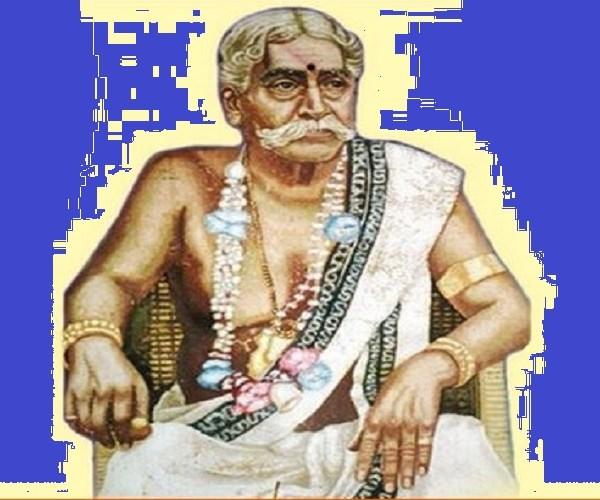The legendry personality ‘Harikatha Pithamaha’ aka Narayana Das was born on 31st August 1864 to Venkata Chayanulu and Lakshmi Narasamamba, in Ajjada, a small village on the shores of Suvarnamukhi in the present Vizianagaram district of Andhra Pradesh.
He was a poet, dancer, vaggeyakara, musician, litterateur, linguist and creator of modern school of Harikatha, a unique art form in Telugu States. Narayana Das, also called as ‘Harikatha Pithamaha’ was born on 31st August 1864 to Venkata Chayanulu and Lakshmi Narasamamba, in Ajjada, a small village on the shores of Suvarnamukhi in the present Vizianagaram district of Andhra Pradesh. He was a poet, dancer, vaggeyakara, musician, litterateur, linguist and creator of modern school of Harikatha, a unique art form in Telugu States.
Das who was a child prodigy with rich retentive memory, was a great scholar in quite a many languages like Persian, Urdu, Hindi, Sanskrit, Bengali, English, Telugu and wrote in pure Telugu without any mixture of Sanskrit.
Das was also a cultural hero, who made music a daily need in Vizianagaram, then cultural capital of AP. He was a great musical genius, a dancer of delight and a poet of rear eminence, and was known for his extempore poetry in Sanskrit and Telugu. His dance and abhinaya were exquisite and were prominent features of his Harikatha performances.
His veena playing skills were remarkable. He was known as ‘Laya Brahma’, and was a nightmare to the accompanists especially the Mardangika (Mridangist).
Inspired by the ‘Dhruvacharitra Harikatha’ performance of Kuppuswamy Naidu Bhagavatar, an art form unknown in Telugu States earlier, who visited Vizianagaram in 1883, Das decided that he would be a Haridas. Das had been a wanderer entertaining huge masses of people with his distinctive art form of Harikatha and won kudos from the cultured.
Among his literary feasts, mention must be made of Ashtavadhanam performances where people used to buy tickets to watch. ‘Navarasatarangini’, ‘Rubayat of Omarkhayam’ and ‘Tarakam’ are other evidences of his feats in literature.
Das gave quite a number of performances, both Veena and Harikathas, in the Court of Mysore Maharajah, who was so pleased not only with Das’s music but also with his speedy and faultless English translation of his story and description. Maharaja once praised Das that he had never heard such beautiful music in his life, and presented a Veena to Das as a gift.
The Maharajah of Vizianagaram who came to know about the glowing tributes paid to Das at Madras, Bangalore, Mysore and other places and the highest reward presented by Mysore Maharajah, appointed him as ‘Asthana Vidwan’ of royal court. He was the first principal of the Vizianagaram Music College, instituted in 1919 by HH Vijayarama Gajapati, Maharajah of Vizianagaram, and presided over for about 19 years.
Das composed around 20 Harikathas. His works in Sanskrit include Harikathamrutam, a compilation of three Harikathas, Tarakam (an original allegorical poem) and two Shatakas – Ramachandra Shatakam and Kashi Shatakam. He translated the Ruks of Rigveda into Telugu verse.
Das extensively travelled from Kolkata to Kanyakumari delivering Katha Kalakshepams, Avadhanas, Veena recitals and was invited and honoured by the then Maharajas and Zamindars. His voice was so melodius that Mysore Maharaja had recorded his voice through phonogram and used to listen frequently.
Notable disciples of Narayana Das were: Vajapeyajula Subbayya Dasu, Neti Lakshminarayana Bhagavatulu (Vijayawada), Nemani Varahala Dasu, Vedanabhatla Venkata Ramanayya, Vadlamani Narasimha Dasu, Pillalamarri Rama Das Bhagavatar, Karur Krishna Das etc.
Das has unique honour of Gajarohana processions multiple times during his triumph and tours in Andhra and Telangana areas. The citizens of Singareni Collieries in Kothagudem organised one such Gajarohana in the year 1934 to celebrate Das’s 70th birthday. In the year 1936 when Das delivered Harikatha in Tulja Bhavan, Hyderabad, over 5,000 plus audience had gathered.
Rich tributes were paid to Das’s literary achievements by his contemporaries in the field, the highest of which was that of ‘Satavadhani’ Chellapilla Venkata Sastry, who said, “Das’s art is like a rose poetry, dance and music”.
Das passed away on 2nd January 1945 and on the same tithi of ‘Pushya Bahula Panchami’ on which day Saint Thyagaraja Swamy also reached the abode.
Das’s statue has been installed in Sivalayam temple premises at Satyanarayanapuram, Vijayawada on January 25, 1951 by his prime disciple ‘Harikatha Kesari’ Neti Lashminarayana Bhagavatar, where in the past 66 years, wide network of his disciples continue the legacy of celebrating Das’s jayanthi (Sravana Bahula Chaturdasi) and death anniversary (Pushya Bahula Panchami). #KhabarLive







